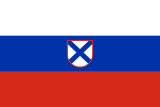Комитет Освобождения Народов России | |
 | |
 Manifestation of the Committee in Berlin, November 1944 | |
| Abbreviation | KONR (КОНР) |
|---|---|
| Formation | November 14, 1944 |
| Founded at | Prague, Bohemia and Moravia |
| Dissolved | February 14, 1946 |
| Type | Collaborator Organisation |
| Purpose | Invade Russia by land and remove Joseph Stalin from power |
| Headquarters |
|
Region | |
Membership (1945) | ≈700 |
Official language | Russian |
Chairman | Andrey Vlasov |
Key people | |
The Committee for the Liberation of the Peoples of Russia (Russian: Комитет Освобождения Народов России, Komitet Osvobozhdeniya Narodov Rossii, abbreviated as Russian: КОНР, KONR) was a committee composed of military and civilian Nazi collaborators from territories of the Soviet Union (most being Russians). It was founded by Nazi Germany on 14 November 1944, in Prague, Protectorate of Bohemia and Moravia (purposely chosen because it was a Slavic city that was still under Axis control).
YouTube Encyclopedic
-
1/3Views:857 9168431 542 548
-
Soviet Storm. WW2 in the East - The Siege Of Leningrad. Episode 5. StarMedia. Babich-Design
-
Flagship Seminar | Revisiting India’s Role in the Bangladesh Liberation War
-
Soviet Storm. WW2 in the East - The Battle Of Moscow. Episode 4. StarMedia. Babich-Design
Transcription
Stated goals
The goals of the committee were embodied in a document known as the Prague Manifesto. The manifesto's fourteen points guaranteed the freedom of speech, press, religion, and assembly, as well as a right to self-determination of any ethnic group living in territories belonging to Russia. The Prague Manifesto did not contain any explicit anti-semitic or other racially inspired rhetoric, which caused a conflict with many Nazi propagandists. However, criticism aimed at the Western Allies (specifically US and UK) was included in the manifesto's preamble. The chairman of the committee was General Andrey Vlasov, who also commanded the Russian Liberation Army. The committee was viewed as the political arm of the Russian Liberation Army.
After the surrender of Germany to the Allies, the committee ceased to operate. During the immediate post-war period, several new organisations sprang up that intended to continue the committee's goal of fighting communism (i.e., the Union of the St. Andrew Flag; the Committee of United Vlasovites; the Union of Battle for the Liberation of the Peoples of Russia), started by veterans of the committee and the Russian Liberation Army who managed to escape forced repatriation to the Soviet Union. Two latter organisations participated in US-led efforts to form a united anti-Soviet platform of Soviet emigres.
In the United States, a CIA-led organisation with a similar name, the American Committee for the Liberation of the Peoples of Russia, was founded in the late 1940s, and became known for their propaganda broadcaster Radio Liberty, which was run by the Central Intelligence Agency and later funded by the United States Congress. It operated from Munich, in West Germany.
Gallery
-
Leaflet of the Russian Liberation Army leaders in 1942
-
General Vlasov's order to prevent Dedovshchina in all forces related to KONR
-
KONR's first session. Prague, 14th November 1944
-
Camp Dabendorf: General Vlasov (2nd from left), General Trochin (1st from left) among German and ROA officers, 1944
-
Vlasov inspects soldiers of the ROA, 1944
-
ROA soldiers in Belgium or France, 1944
-
Brochure of the Committee for the Liberation of the Peoples of Russia
-
New Year's greetings from the Committee for the Liberation of the Peoples of Russia
See also
- Anti-Bolshevik Bloc of Nations
- National Committee for a Free Germany
- Russian Liberation Movement
- Ukrainian National Committee








